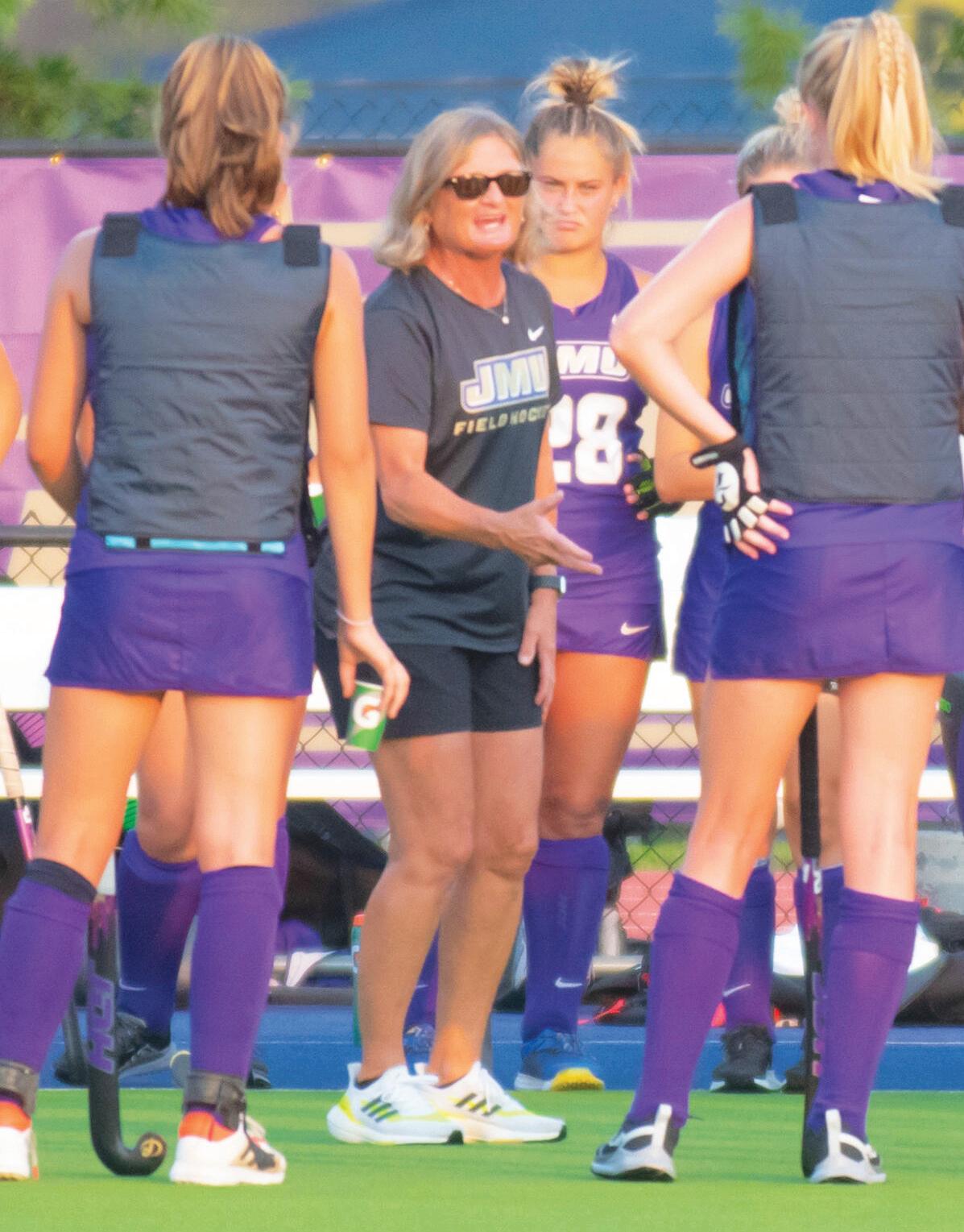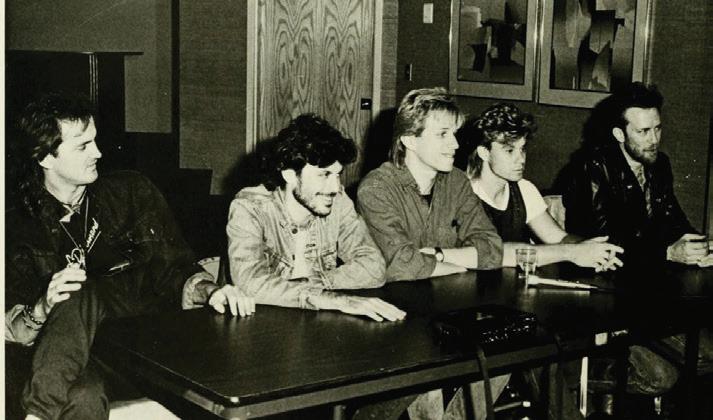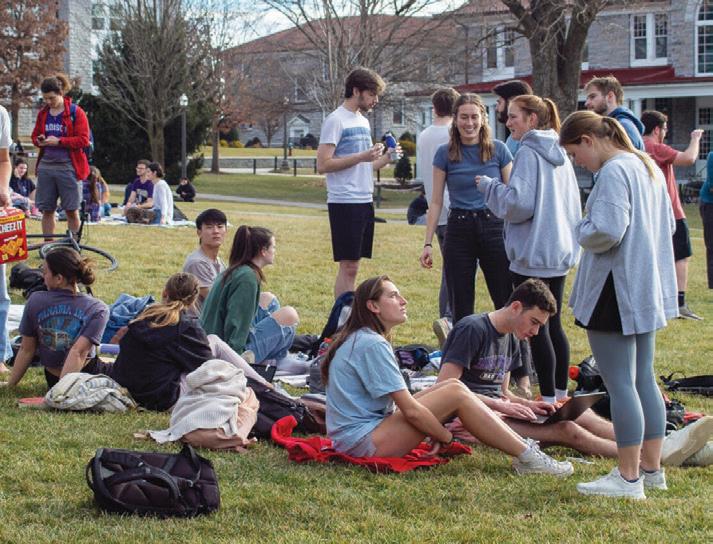
11 minute read
She did it first
JMU field hockey coach Christy Morgan reflects on the 1994 National Championship
police called me, and I had to come in and claim my car and let them know that it’s OK, it’s not vandalism, it’s just people having a little fun and celebrating.” came back to JMU was she knew JMU could return to greatness. JMU is a place that supports its athletes and sports, Morgan said, and that it’s something that attracts both wholesome athletes and people. Morgan described JMU as a “place you want to be.”
Advertisement
Morgan said JMU’s road to the national championship came with adversity. On its way to the semifinal game in Boston, Morgan said the bus didn’t show up. The JMU players waited outside for the bus and as game time got closer, the team jumped into cab, and arrived 30 minutes before game time.
By WILL MORAN The Breeze
JMU field hockey head coach Christy Morgan went to a marketing official during the 1994 season to talk about getting some perks that some of the other coaches JMU had.
“I said ‘Look, if we win a conference championship, I say that you work on getting me a courtesy car,’” Morgan said. “And he said ‘No, you’d have to win the national championship, and then I’ll make it happen.’”
Morgan made it happen.
She won three national championships as a player during her time at Old Dominion (1982-85). After winning the 1994 national championship as JMU’s coach, she became the first person in NCAA history to win a field hockey title as both a player and a coach, something she credits to her drive.
The Dukes finished 1994 with the best record in the CAA at 16-2-1. They fell 2-1 in overtime in the conference championship game to Old Dominion, but still gained an at-large bid to the NCAA tournament.
Morgan said losing the conference title game helped the Dukes in the long run.
“Any loss is just a great opportunity to learn, I think it ended up being a blessing in disguise because nobody wants to lose, especially in the conference championship,” Morgan said. “It did give us a little bit more motivation to get better, so that we were good enough to win it all.”
JMU played Penn State in the quarterfinals. The Dukes beat the Nittany Lions to advance to the Final Four and, rightfully so, Morgan said the team celebrated the win, but not how one might think.
“At like 2 o’clock in the morning,” Morgan said, “my car was toilet-papered by the team, by the players … The campus
“I think a lot of people go into tough situations with fear, we went in with excitement for the opportunity,” Morgan said. “And knowing that we had tools to get it done, we just had to step on the field and we had to get it done.”
JMU wasn’t thrown off by the routine change. Morgan said she was stressed as the warmup was cut in half as she likes to stick to a standard of preparation, but the team took charge and ensured that everything would be alright.
“They’re like, ‘Don’t worry coach, we got this,’” Morgan said. “A little bit of adversity, it’s a motivator for us.”
After winning the championship, naturally, it aided the program in its recruiting efforts from then on. Morgan said “the best of the best” were knocking on the door to come to JMU in the hopes of bringing another national championship to Harrisonburg.
Morgan was away from JMU from 1999-2014 and was away from the sport entirely from 2001-2011. During her time away she was the head coach at Davidson in 2001 and the associate head coach at Wake Forest from 2011-2013.
Morgan said part of the reason she
Once the team returned to Harrisonburg after winning the national championship, her wish of a courtesy car, and a crowd of JMU fans, were waiting for her. Winning a championship was one thing, but JMU nation being excited about the accomplishment made it special, Morgan said.
“When we came home, they had a green Jeep waiting, and it was 2 o’clock in the morning. When we got off the plane, when we came home and we came into Godwin parking lot, the AD was there, there were about 250 people there, that late, that early in the morning,” Morgan said. “They had the Jeep and all the girls piled in the Jeep, and we have pictures, and it was amazing.”
Looking back on the milestone, Morgan said the legacy of the team is how connected they were. She said the team wouldn’t have achieved what they did in that season if they weren’t so close both on and off the field.
“When you can lead a team that’s never done it before, from a school that’s never done it before,” Morgan said, “to a place that no one has ever been and then succeed, it’s the most powerful thing.”
CONTACT Will Moran at moranwp@dukes. jmu.edu. For more field hockey coverage, follow the sports desk on Twitter @TheBreezeSports.
1980s want whenever we want. Men in the ’90s wore colorful or printed tops matched with cuffed jeans or overalls. Baggy pants of many varieties were very popular. The fashion during this time centered a combination of comfortability and style.

Bold styles were all the rage during the ’80s. The women of JMU sported big shoulder pads and explosive colors that were common in ’80s fashion, and many had big hair and extreme perms. The ’80s also saw colorful thigh warmers, chunky black boots and chains. These pieces were staples in the goth punk style. “Ferris Bueller’s Day Off” and “Stranger Things” are perfect examples of prime ’80s fashion. Cuffed jeans or khakis paired with bomber jackets or loafers were very popular, plus the occasional “bad boy” leather jacket could be spotted. Women weren’t the only ones with big hair — men popularized the mullet, which has recently made a comeback.


2010s
Skinny jeans survived into the 2010s but became high-waisted. Brand name footwear such as Doc Martens and Manolo Blahniks were staples in many closets. Fashion inclusivity became more popular during this time, making the fashion industry more accepting of different shapes and sizes. Vintage style, largely inspired by “Downton Abbey” and “The Great Gatsby,” saw a revival during the 2010s, which paved the way for another trend: thrifting. Many shoppers wanted to get the most bang for their buck, which made reselling and buying secondhand clothes very popular. Today, some stores sell only second-hand clothes because the market has become so profitable. The 2010s was a melting pot of styles that came before, which gave individuals a wide selection of styles to choose from.
2000s
Fashion during the early 2000s was everchanging. The fashion and music industries continued to influence one another with popular rappers like Jay Z and Eminem having their own clothing lines. Both men and women sported low-waisted skinny jeans, which were popularized by various celebrities at the time. Bohemian style also rose in popularity, encouraging women to layer clothing pieces and combine loud patterns fearlessly. It wouldn’t be the 2000s without every celebrity or teenager of the time wearing bright yellow “LiveStrong” bracelets, which raised money for individuals living with cancer, then became a trend with other fashion brands making similar wristbands. As seen in “Gossip Girl,” pleated skirts, ballet slippers, headbands and a preppy style were seen everywhere.
1990s
Women’s styles in the ’90s were more about darker shades, minimalistic trends and grunge/rock looks. Music trends heavily influenced fashion, and the ’90s gave off the impression that we can do whatever we
We live in an era plagued by extreme political polarization, “fake news” and misinformation, all of which have eaten away at the American news and media industries like an untreatable disease. A disease that is slowly eroding the pillars of America’s esteemed democracy, two of which are the rights to free speech and press. The steady downfall of Americans’ trust in the news industry threatens the fragile system we are so accustomed to, a system that must be saved for the very wellbeing of our country.
Despite increasing uncertainty about what the future may hold, journalism remains essential in our society. Journalism on every level contributes to the protection of the right to free speech and press, from high school and college newspapers to world-renowned newspapers such as The New York Times.
According to the Washington Post, local newspapers are rapidly disappearing around the country, creating “news deserts,” in which access to reliable and quality news is extremely difficult, and many of these communities are in rural regions that are often economically struggling. In small towns, a school newspaper may be the only source of information for the community. While this is not the case at JMU, The Breeze still plays a major part in the Harrisonburg news scene.
According to Ryan T. Alessi, a professor in media arts and design at JMU, newspapers and reporters are necessary in communities to keep officials transparent.
“The presence of those news organizations and reporters asking questions oftentimes keeps officials in check” Alessi said. “If they know they’re going to be questioned aggressively by a local reporter about why a specific ordinance was passed or what the tax rate is going to be, that’s going to make the officials think twice, and when those news organizations go away — all kinds of things confess during the darkness.”
Though university newspapers aren’t often on the national stage, they serve individual communities all across the country. The Breeze is one of JMU’s many connections to the

Harrisonburg community and gives students the ability to work with other students, faculty and Harrisonburg citizens and businesses. College and local newspapers cover both local, state and national issues — especially those concerning the community.
Senior Blair Hinckle said she reads The Breeze monthly to stay updated on university changes and to read articles that interest her, especially those relating to her position on Panhellenic council.

“I think that college newspapers are a great way to be informed about events happening in our community,” Hinckle said.

The Breeze alerts the JMU community of university updates and changes, including new faculty and dorm buildings, regulations and other issues. In the Feb. 11, 1967, issue of The Breeze, the newspaper reported on a recent room search, student government updates, new majors, the addition of a new dorm and even a best-dressed competition.
In 1966, it was announced that JMU, formerly Madison College, would accept male students for the first time. The enrollment of male students led to the implementation of new campus rules and regulations, which gave student writers the opportunity to spread the word to the Madison College and Harrisonburg communities. In the Sep. 30, 1967, issue of The Breeze, it announced the addition of male dormitories on campus:

“The construction of the five men’s dormitories to be erected on Madison’s lower campus in the next six years is underway,” the article reads. “Madison’s expansion program, if all progresses as is planned, will bring the number of women students to 3,200 and the number of men students to 1,800 to be housed in the campus by the 197374 session.”
During election years, college newspapers provide the community with essential election information, including election results and analysis. During the 2022 midterm elections, The Breeze news desk provided information on candidates and held live election results online for both Virginia’s congressional election and local Harrisonburg elections. Journalists at all levels are increasingly vital
2020s
The decade of 2020 has barely begun, but there’ve already been notable fashion trends. Colorful eye makeup has become a form of self-expression, which adds to the unique outfits of this decade. Loose jeans with tight crop tops is a go-to outfit for female students. Diversity is in, and toxic masculinity is out. Feminine styles with pastels and frills are becoming more common with both men and women wearing blouses and skirts or dresses to high-profile events. Jewelry like pearl necklaces and previous fashion trends have been revived in this new decade with both women and men sporting mullets again. Thanks to celebrities like Harry Styles, gender lines are blurring and traditional ideas of what men’s and women’s wear has to look like are changing.
Looking back, some fashion trends may not be everyone’s cup of tea, but a revisit to the world The Breeze was born into and understanding the world it grew up in is important so we can appreciate how far we’ve come and be proud of where we are heading.

CONTACT LillyAnne Day at daymillm@ dukes.jmu.edu. For more on the culture, arts and lifestyle of the JMU and Harrisonburg communities, follow the culture desk on Twitter and Instagram @Breeze_Culture.
Want to praise someone or get something off your chest? Darts & Pats is the place to do it. Submit your own at breezejmu.org.
Pat...
A “cheapest-show-intown” pat to the guy across the parking lot from us who left his bedroom blinds wide open on Thursday evening.
From two senior girls who think that next time you decide to “air dry,” you should either close the blinds or charge for admission.
March 26, 2006
Dart...
A “you-can-replacethat-now” dart to the guy in Hillside Hall who urinated on my bean bag chair, thinking it was the bathroom.
From a student who thinks you are disgusting and that you should buy him a new chair, since he’s never going to use that one again.
October 14, 1999 amidst the crisis in the news and media industries. Misinformation and disinformation can run rampant across all forms of media, from social media platforms like Twitter and Facebook to Fox News, MSNBC and parody news sites such as the Onion.
While many choose to get their news from commentators such as conservative commentator Tucker Carlson from Fox News and liberal commentator Rachel Maddow from MSNBC, their words can’t always be taken verbatim as the real facts, as opposed to reporters and news anchors like Fox’s Bret Baier and MSNBC’s Chris Jansing.
Alessi explained that news organizations can’t control their audiences’ responses and opinions shaped by the news, and it becomes difficult for individuals to identify the facts from “the facts and information packaged in somebody else’s opinion.”
“On Twitter people are often commentating about and commenting on the news itself, and if its the commentary that’s reaching audiences more so than the actual facts, things can get twisted and distorted, in which case the debates might get twisted and distorted themselves because people aren’t talking about the underlying facts, they’re debating the opinions that are packaged in that hyper-partisan framework,” Alessi said.
Student newspapers across the country provide communities with reliable and trustworthy news sources and have the opportunity to connect and work with not just other students and faculty but their communities as a whole.
University newspapers and student journalists are essential to not only our society but our overall democracy. They’re not just student journalists, they’re real journalists, and they contribute to our communities in incredibly positive ways. They’re the coming generation of reporters, editors, news anchors, writers and commentators, facing an era shaped by a media crisis never seen before. CONTACT at seliek@dukes.jmu. edu. For more editorials regarding the JMU and Harrisonburg communities, follow the opinion desk on Instagram and Twitter @Breeze_Opinion.
Pat...
A “mystery-girl” pat to the girl who picked me up off of South Main Street, drove me home, changed my clothes and let me sleep in her apartment so she could take care me.
From a student who doesn’t know when to say when.
February 16, 1995
Dart...
A “get-a-clue” dart to the professor who asked me if I was going to perform a terrorist act on the ISAT bridge when I was doing global position work for my geographic information systems class.
From an Iranian-American student who is proud to be an American and sick and tired of ignorant people like you.
November 15, 2001









